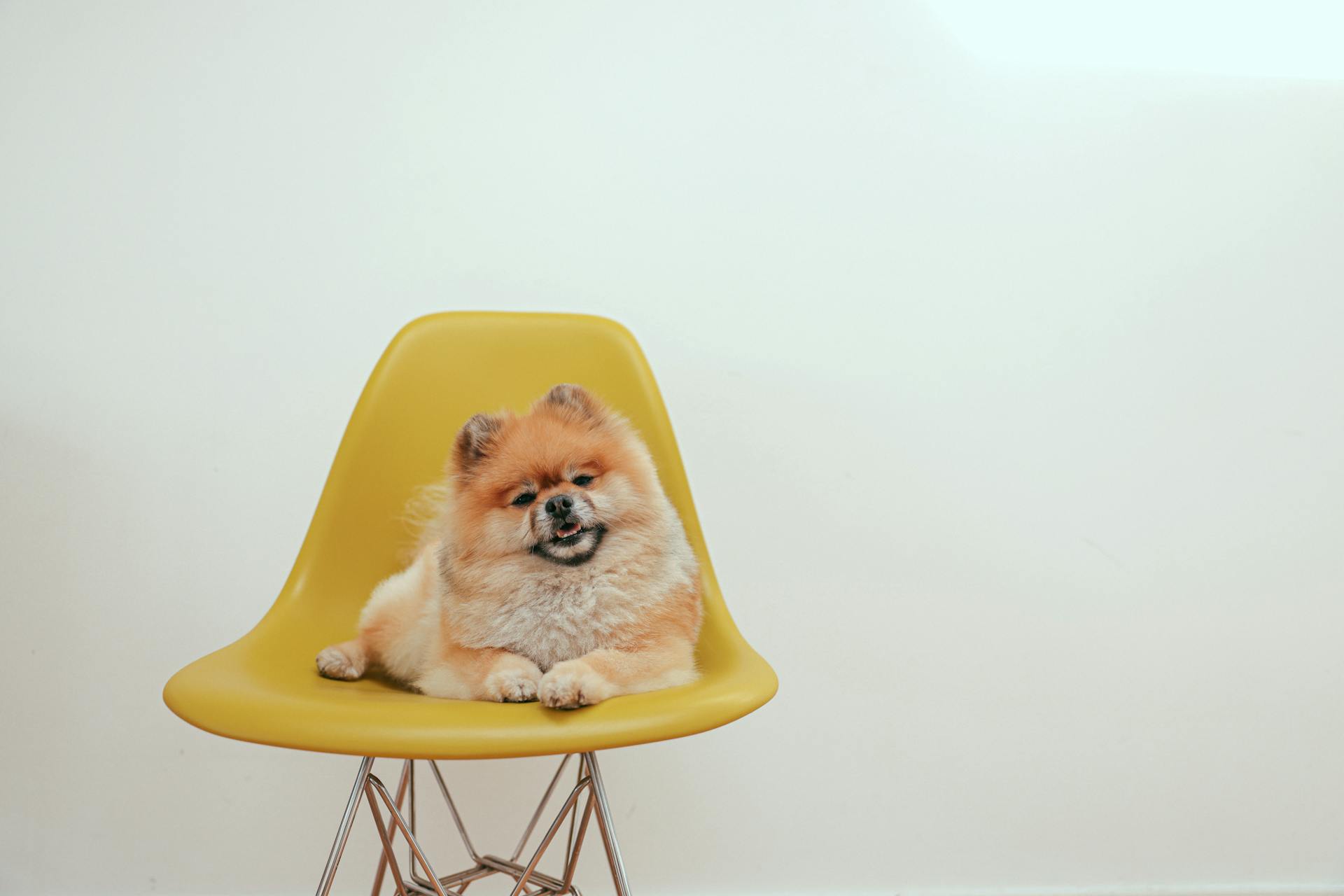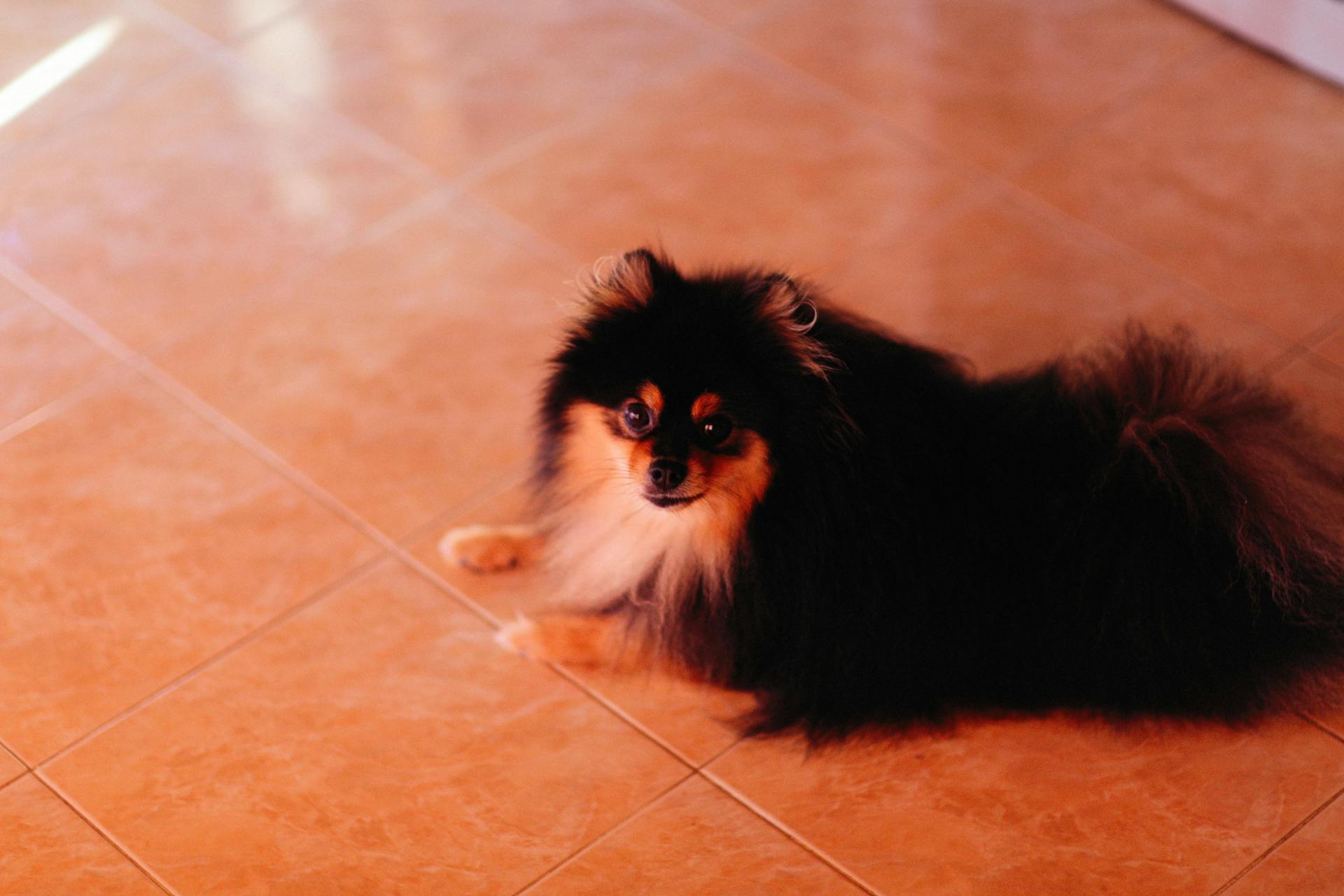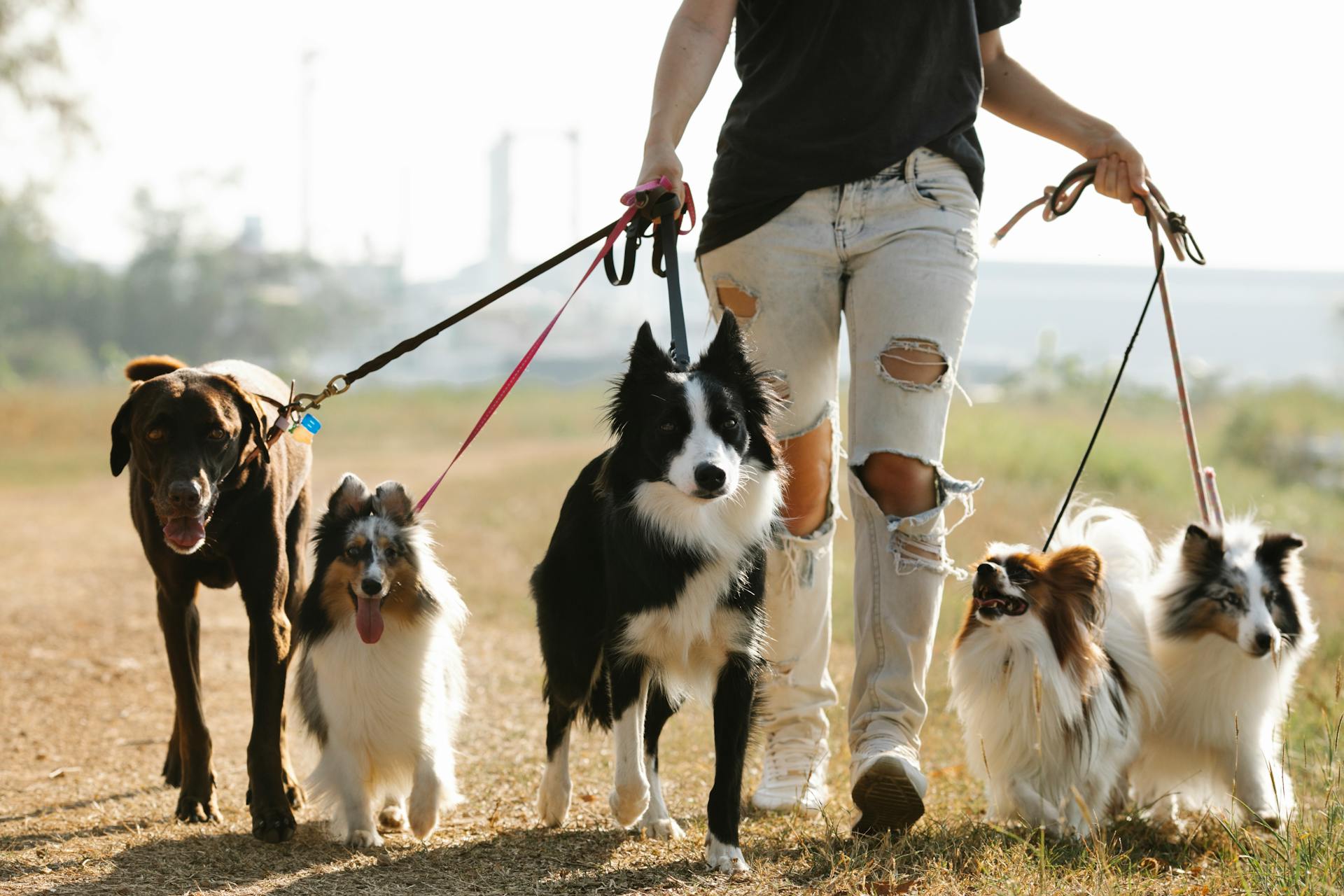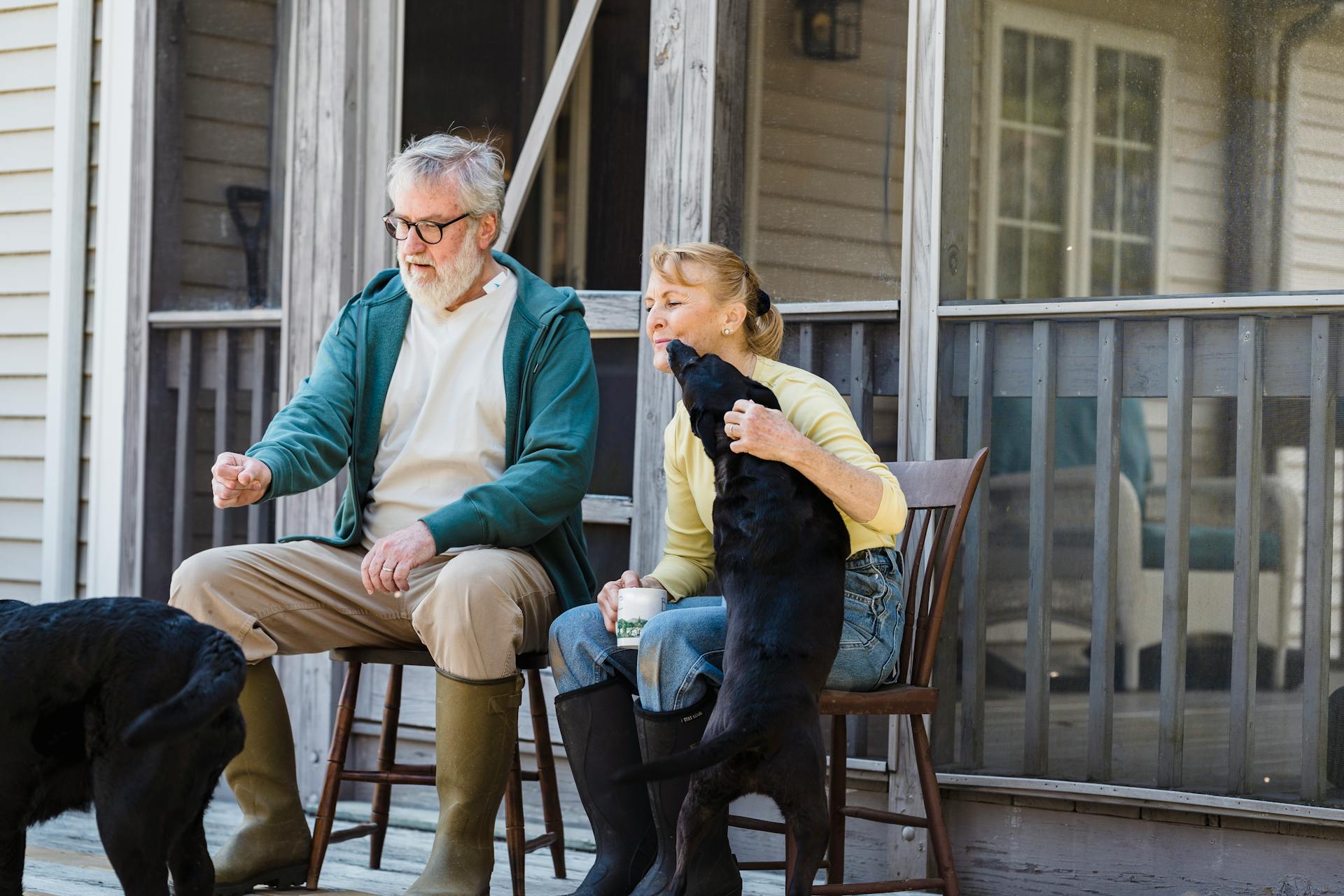
Pomeranian Teddy Dogs are a popular breed known for their fluffy coats and adorable appearance. They typically weigh between 3-7 pounds and stand about 6-11 inches tall.
To care for a Pomeranian Teddy Dog, it's essential to brush their coat regularly to prevent matting and tangling. This can be done daily, especially during shedding season.
Pomeranian Teddy Dogs are intelligent and trainable, but they can be stubborn at times. Consistent positive reinforcement training is recommended to help them learn good behavior.
A Pomeranian Teddy Dog's diet should consist of high-quality dog food, and they require regular exercise to stay healthy.
Physical Characteristics
A Pomeranian Teddy dog is a tiny bundle of joy with a big personality. They typically weigh no more than 7 pounds.
Their face is often described as fox-like, thanks to a wedge-shaped head and erect ears. Their sweet, almond-shaped eyes are dark.
Poms come in a wide range of colors, including orange, red, black, blue, chocolate, cream, and white. Orange and red are the most common colors.
Suggestion: Pomeranian Dog Colors
A healthy Pomeranian can live for 16 years or more with good care. However, they are prone to certain health conditions, including congestive heart failure, black skin disease, patella luxation, and seizure disorders.
Here are the key physical characteristics of a Pomeranian Teddy dog:
- Ears: Small, erect, and sit high on the head.
- Eyes: Dark and bright, medium-sized and almond-shaped.
- Nose: Black, but can also be self-colored in blue-gray, chocolate, and beaver breeds.
- Coat: Double coat, with short, thick fur below and an abundant coarse outer coat.
- Coat Color: 2 dozen color options, including patterns and markings.
- Tail: Thickly plumed, set high up on the back and lies flat.
Temperament and Training
Pomeranians are happy-go-lucky dogs with a friendly and inquisitive personality. They live for social interactions and love to make their owners laugh.
They're not typically aggressive, but it's essential to teach children how to handle them with care. Poms are also compatible with other pets, including dogs, cats, and children.
Pomeranians are highly intelligent and can pick up fun new tricks quickly. They excel in obedience classes and can even become therapy dogs or watchdogs.
Their curious nature can sometimes get them into trouble, especially around larger dogs. But with proper training, they can learn to navigate these situations.
Housebreaking can be a challenge, especially for small breeds like Pomeranians. Start training as soon as possible, and remember to reward good behavior and ignore accidents.
Readers also liked: Are Pomeranians Chihuahuas
Temperament
Pomeranians are known to be friendly and inquisitive, living for social interactions and making their owners laugh out loud.
They're generally not aggressive, but like any dog, they may snap if provoked, so it's essential to teach children to handle them with care.
Pomeranians are highly intelligent and adept at picking up new tricks, making them a great fit for obedience classes.
Their keen intelligence also makes them excel at jobs like therapy dog work and watchdog duties.
Poms are naturally protective of their family and territory, often barking to alert their owners to potential threats.
Their curious nature means they can get into trouble, especially around larger dogs, so it's crucial to supervise interactions.
Despite their small size, Pomeranians have a big personality and can be quite confident, even a bit cocky, which is reflected in their proud gait and bouncy personality.
Their playful and happy nature makes them a joy to be around, and they'll often adapt to whatever activities you have in store for them.
Pomeranians are also known to be gentle little souls with a funny sense of humor, making them a great addition to many families.
Explore further: Hypoallergenic Dogs Pomeranian
They're Easy to Train
Pomeranians are known for their intelligence, and they can learn quickly with the right training. They're eager to please their owners and can learn basic obedience skills in no time.
Housebreaking is a crucial part of training, and accidents can happen, especially with tiny pups and their small bladders. Training pads are a good option inside, and the Pet Parents washable dog pee pads with a non-slip backing are a great choice.
The "off" or "down" command is essential to master early on to prevent Poms from jumping onto furniture. A Pom's "big-dog bluster" may lead them to think they can leap tall sofas in a single bound, but this practice could actually end with injured joints or even a broken bone.
They can learn not only basic obedience skills but also tricks, making them a great choice for those looking for a pup to earn AKC trick titles with.
Explore further: All about Dogs Dog Training
Housebreaking Can Be a Challenge
Housebreaking can be a challenge, especially in smaller breeds like Pomeranians. They may need potty breaks as often as every 15-20 minutes when they are awake and after eating or drinking.
You can start training as soon as you bring your dog into your home. Show them where you want them to do their business and reward them when they do.
Accidents will happen, so it's essential to ignore them and not punish your pup. This will help prevent accidents from becoming a source of stress and anxiety for both you and your dog.
Taking your dog outside frequently and on a regular schedule will help them get the hang of it.
For more insights, see: What Can You Feed Dogs Other than Dog Food
They Can Be High Maintenance
Pomeranians are double coated pups that require a thorough brushing 2-3 times a week at a minimum.
Their signature fluffy manes can get matted and tangled if not brushed regularly, leading to painful hairballs and skin irritation.
A full groom every 4-6 weeks is essential to keep them looking their best and prevent health issues.
This includes a bath, brush out, ear cleaning, nail trim, teeth brushing, and potentially having their anal glands expressed.
If you can’t keep up with the expense, or learn to perform some of these services yourself, you may want to consider another breed.
Grooming and Care
Grooming your Pomeranian is a must every one to four weeks, which includes bathing in warm water, brushing their teeth, and brushing their thick coat with a wire pin brush.
Their undercoat is soft and dense, while their outer coat is long, straight, and coarse. Brushing their coat a few times a week with a medium to hard brush will help reduce shedding.
They only need to be bathed every couple of months, but regular brushing will keep their coat looking sharp. A complete grooming package every four to six weeks includes bathing, brushing, and a haircut, as well as cleaning their teeth, ears, and anal glands, and clipping their nails.
You might enjoy: Dog Grooming for Difficult Dogs
Care
Pomeranians have a double coat, which means their undercoat is soft and dense, while their outer coat is long, straight, and coarse.
Their ample coat should be brushed a few times a week with a medium to hard brush that can get all the way to their skin.
Brushing their coat regularly will help reduce shedding.
Pomeranians are prone to dental health issues, so make teeth brushing part of your regular routine.
They only need to be bathed every couple of months, but you should still brush their teeth a few times a week, ideally daily.
Poms don't require a ton of exercise and are happy to go on a short walk or two each day, although they have the stamina to go on longer walks if you'd like.
They love to both snuggle up on your lap and play around the house, making them great companions.
Training them to walk on a leash and come when called is crucial, as is house training, which can be a bit tough due to their dislike of going outside in cold or rainy weather.
Early socialization is essential to help them interact with the world as they get older, and they can be yappy dogs if not trained properly.
You might like: Soft Food for Dogs with No Teeth
Nutrition They Need, Food They Want
When it comes to providing the right nutrition for our pets, we need to consider their specific needs based on their age, breed, and lifestyle.
Dogs require a balanced diet that includes protein, fat, carbohydrates, vitamins, and minerals.
As we age, our pets' nutritional needs change, and senior dogs require more joint support and less protein.
Cats are obligate carnivores, meaning they need a diet rich in animal protein and fat to stay healthy.
Feeding our pets a balanced and varied diet is essential for their overall health and well-being.
A healthy coat is a reflection of a pet's overall health, and a diet rich in omega-3 fatty acids can help promote a shiny and healthy coat.
Consider reading: Fat Min Pin
Health and Wellness
As a Pomeranian owner, I've learned that these tiny dogs are generally healthy, but they can be prone to some health issues. Patellar luxation, which causes the kneecap to pop out of place, is a common problem that can lead to limping and arthritis.
Pomeranians are also susceptible to collapsing tracheas, which can cause respiratory distress. A harness is a better choice than a traditional neck collar to prevent putting pressure on the trachea. Regular exercise and a healthy weight can help prevent this issue.
Some Pomeranians may also experience hypothyroidism, which can cause lethargy, hair thinning, and weight gain. A vet can run a blood test to diagnose this issue, and it can be regulated with medication. Regular check-ups with your veterinarian are crucial to catch any potential health problems early on.
Some health issues to watch out for in Pomeranians include:
- Patellar luxation
- Collapsing tracheas
- Hypothyroidism
- Hip issues (Legg-Calve-Perthes disease and hip dysplasia)
- Eye problems (cataracts and entropion)
- Hair loss (Severe Hair Loss Syndrome or Pomeranian alopecia)
By being aware of these potential health issues, you can take steps to prevent or manage them, and ensure your Pomeranian lives a happy and healthy life.
Health
Pomeranians are generally healthy canines, but like any breed, they can be prone to certain health issues. Patellar luxation, which causes the kneecap to pop out of place, can be painful and lead to arthritis.
Collapsing tracheas are another issue that can affect Poms, causing symptoms ranging from a mild cough to severe respiratory distress. A harness can help alleviate pressure on the trachea when walking.
Hypothyroidism is a common condition in Poms, causing lethargy, hair thinning, and weight gain. Regular blood tests can diagnose this issue, and it can be regulated with medication.
Pomeranians can also be prone to hypoglycemia, a condition of low blood sugar, especially in small or very active Poms. Keeping your puppy fed on a regular schedule can help prevent this issue.
Hip issues, such as Legg-Calve-Perthes disease and hip dysplasia, can develop in Poms, causing pain and mobility problems. Surgery may be needed to correct these issues.
Eye problems, such as cataracts and entropion, can also affect Poms. These conditions can be diagnosed and treated by a veterinary ophthalmologist, possibly with surgery.
Here are some common health issues that can affect Pomeranians:
- Patellar luxation
- Collapsing tracheas
- Hypothyroidism
- Hypoglycemia
- Hip dysplasia
- Cataracts
- Entropion
It's essential to work closely with your veterinarian to monitor your Pomeranian's health and catch any potential issues early on. Regular check-ups and a balanced lifestyle can help prevent many of these health issues.
Related reading: Pomeranian Dog Health Issues
10 Signs Your Pet Needs a Vet Visit
Recognizing when to take your pet to the vet can be a challenge, especially during weekends or overnight.
If your pet is vomiting or having diarrhea, it's essential to take them to the vet as soon as possible.
A lack of appetite can be a sign that your pet is not feeling well.
If your pet is showing signs of lethargy, such as being less active or less responsive, it's a good idea to take them to the vet.
Your pet's breathing rate can be a crucial indicator of their health, so if you notice they're breathing rapidly or with difficulty, seek veterinary attention.
If your pet is showing signs of pain, such as whining or limping, it's time to take them to the vet.
Your pet's temperature can be a good indicator of their health, so if you notice it's elevated or decreased, take them to the vet.
If your pet is having trouble walking or standing, it could be a sign of a serious underlying issue.
Your pet's gums can be a good indicator of their health, so if you notice they're pale or blue-tinged, seek veterinary attention.
If your pet is showing signs of bleeding or discharge, such as from their nose, mouth, or rectum, it's essential to take them to the vet.
Discover more: Vets Dog Treats
Living Needs
Pomeranians are surprisingly hearty, active little pups who enjoy getting out for walks, and they're perfect for apartment life or homes with small yards.
They don't need much pampering or fussing, making them ideal pets for older or busy people.
Poms love to play and perform for an audience, so make sure you have plenty of toys around to challenge their active minds and rotate them out to keep things fresh.
You'll need to supervise young children around any dog and teach them how to properly interact with animals, as Poms can be fragile and sometimes thought of as toys.
Poms can co-exist with cats and other dogs, but they will need supervision around bigger dogs.
Early socialization is key to keeping them from getting into trouble, so make sure to expose your Pomeranian puppy to new people, dogs, and situations.
Camping Tips
Taking your dog camping can be a fantastic way to spend quality time together. Taking your dog with you can add tons of fun and be an enriching experience for your beloved pup.

If you aren't already camping with your dog, you might be wondering where to start. Looking to savor the last of the summer fun and head out for one last camping trip?
Before you go, make sure to plan ahead and consider the length of your trip. 7 Tips for Camping With Your Dog suggests planning for at least a few hours of outdoor activities each day to ensure your dog gets enough exercise.
Camping with your dog can be a great way to strengthen your bond and create lasting memories. Taking your dog with you can add tons of fun and be an enriching experience for your beloved pup.
Frequently Asked Questions
Is a Pomeranian a teddy bear dog?
No, Pomeranians are not a specific breed called "Teddy Bear" dogs, but rather a breed that can resemble a teddy bear due to their fluffy fur and physical characteristics. If you're looking for a dog that looks like a cuddly teddy bear, a Pomeranian might be a great fit.
How much do teddy bear Pomeranians cost?
Pomeranians, including the teddy bear variety, can cost between $600 and $6,000, depending on factors like breeder reputation and bloodline. If you're considering bringing a teddy bear Pomeranian home, learn more about their temperament, grooming needs, and training requirements.
What is the personality of a teddy bear Pomeranian?
Pomeranians, including Teddy Bear Pomeranians, are affectionate, playful, and adaptable companions. They thrive in homes with regular interaction and attention, making them a great fit for families with children and other pets.
Do Pomeranian teddy bears shed their hair?
Yes, Pomeranians shed heavily due to their thick double coats, with heavier shedding occurring seasonally
Featured Images: pexels.com


